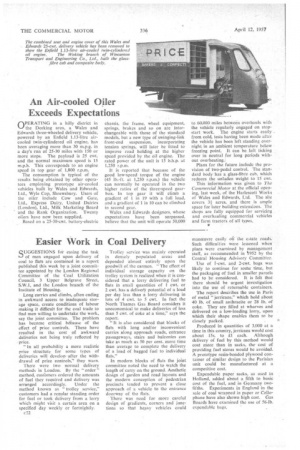Easier Work in Coal Delivery
Page 62

If you've noticed an error in this article please click here to report it so we can fix it.
SUGGEST1ONS for easing the task of men engaged upon delivery of coal to flats are contained in a report published this week by a joint committee appointed by the London Regional Committee of the Coal Utilization Council, 3 Upper Belgrave Street, S.W.1, and the London branch of the Institute of Housing.
Long carries and climbs, often ending in awkward access to inadequate storage space, create conditions of labour making it difficult for the coal trade to find men willing to undertake the work, say the joint committee. The problem has become critical because of the effect of price controls. These have resulted in the cost of awkward deliveries not being truly reflected by price.
" In all probability a more realistic price structure for some types of deliveries will develop after the withdrawal of price controls," they warn.
There were two normal delivery methods in London. By the " order " method, custhmers ordered the amounts of fuel they required and delivery was arranged accordingly. Under the method known as "trolley service," customers had a regular standing order for fuel or took delivery from a lorry which might visit a certain area on a specified day weekly or fortnightly.
c22
Trolley service was mainly operated in densely populated areas and depended almost entirely upon the goodwill of the carmen. "The effect of individual storage capacity on the trolley system is realized when it is considered that a lorry delivering fuel to flats in small quantities of 1 cwt. or 2 cwt. has a delivery potential of a load per day less than a lorry delivering in Jots of 4 cwt. to 5 cwt. In fact the North Thames Gas Board considers it uneconomical to make deliveries of less than 5 cwt. of coke at a time," says the report.
" It is also considered that blocks of flats with long and/or inconvenient carries along approach roads, entrance passageways, stairs and balconies can take as much as 50 per cent. more time than average to complete the delivery of a load of bagged fuel to individual flats."
In modern blocks of flats the joint committee noted the need to watch the length of carry on the ground. Aesthetic design of garden and road layouts and the modern conception of pedestrian precincts tended to prevent a close approach of a vehicle to the entrance doorway of the flats.
There was need for more careful design of gradients, corners and junctions so that heavy vehicles could
manoeuvre easily off the c.,tate roads. Such difficulties were lessened when plans were examined by management staff, as recommended in 11952 by the Central Housing Advisory Committee.
Use of 1-cwt. and 2-cwt. bags was likely to continue for sortie time, but the packaging of fuel in smaller parcels had to be considered. It is felt that there should be urgent investigation into the use of returnable containers.
The report describes the use in Paris of metal " jerricans," which hold about 40 lb. of small anthracite or 28 lb. of coke. They are filled at wharves and delivered on a low-loading lorry, upon which their shape enables them to be closely packed,
Produced in quantities of 3,000 at a time in this country, jerricans would cost about 15s. to £1 each. Although delivery of fuel by this method would cost More than in sacks, the cost of providing fuel stores would be avoided. A prototype resin-bonded plywood container of similar design to the Parisian unit could be manufactured at a competitive cost.
Expendable paper sacks, as used in Holland, added about a fifth to basic cost of the fuel, and in -Germany twofifths. Experiments in England in the sale of coal wrapped in paper or Cellophane have also shown high cost. Gas Boards have examined the use of 56-1b. expendable bags.








































































































